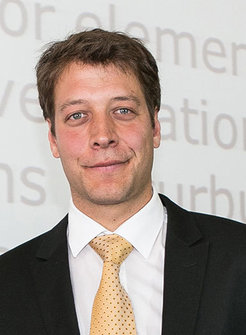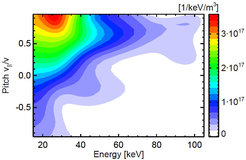Fast particles in hot plasmas
IPP physicist selected as head of a Helmholtz young investigators group
IPP scientist Dr. Benedikt Geiger is one of 17 young researchers to be selected by the Helmholtz Association from 250 applicants to set up his own research group.

IPP scientist Dr. Benedikt Geiger is one of 17 young researchers to be selected by the Helmholtz Association from 250 applicants to set up his own research group. This was preceded by a multi-stage competition process with external expert assessment. Benedikt Geiger will now be supported for five years with 250,000 Euro p.a.
Benedikt Geiger, born 1982 in Rosenheim, Germany, is conducting research on particle motion in hot fusion plasmas. This involves two different particle species: Firstly, there are the fast helium nuclei produced in the fusion process, these ensuring through their high kinetic energy that the plasma retains its temperature even without heating. The energy balance of the power plant requires that these particles remain confined in the magnetic cage long enough to allow them to pass on their energy to the plasma. Secondly, there are the heavy impurity particles emitted by the wall of the plasma vessel. These extract thermal energy from the plasma and conduct it out of the plasma in the form of electromagnetic waves. These unwanted particles should therefore be removed from the magnetic cage as soon as possible.

Benedikt Geiger and his group are to determine in detail what mechanisms are involved in these transport processes and how they are to be controlled. As two different devices are available to IPP, viz. at Garching the ASDEX Upgrade tokamak, at Greifswald the Wendelstein 7-X stellarator, the group will be able to test how the different structures of the magnetic cages affect their particle transport. To simulate the helium produced in fusion, hydrogen is injected into the plasma by neutral-particle injection. The motion in the plasma volume can then be determined with spectrometers. In collaboration with the University of Greifswald, heavy impurity ions can be precisely directed into the plasma by laser ablation. A pulsed laser smelts the surface of a coated glass carrier plate. X-ray cameras and spectrometers then observe the particles’ paths in the plasma. The experimental results are then compared with the theoretical predictions.
The Helmholtz programme is not only for promoting talented young scientists, but also for enhancing networking between Helmholtz centres and partnered universities. Benedikt Geiger, for example, will give lectures at the University. Including this year’s – the twelfth – selection round, the Helmholtz Association has hitherto brought 200 young scientists groups into being. The costs are evenly shared by the institute selected and by the Helmholtz Association, of which IPP is an associate.

